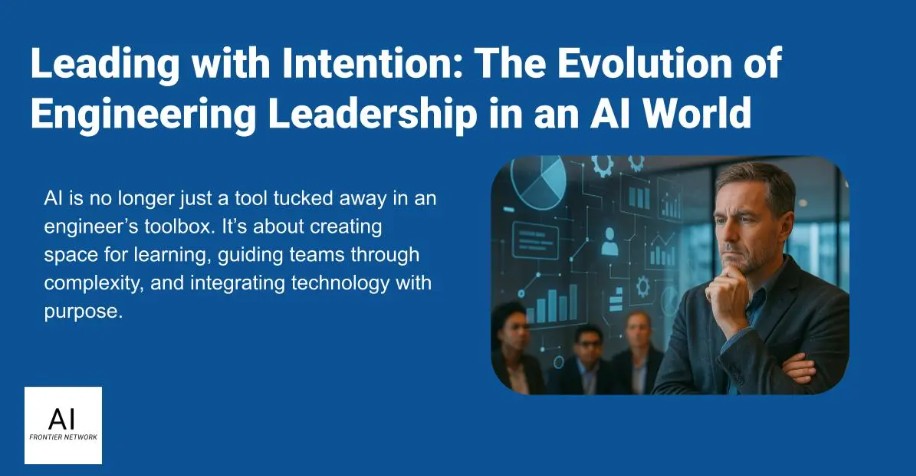
Synthetic Intelligence is not only a instrument tucked away in an engineer’s toolbox, it’s turning into a co-creator, a strategic advisor, and even a cultural power inside organizations. As these eight leaders reveal, AI is radically reworking how management seems to be and feels. It’s not about having all of the solutions anymore; it’s about creating house for studying, guiding groups by way of complexity, and integrating expertise with objective.
From Authority to Intentionality
Previously, management typically equated to manage—setting course, reviewing outputs, and signing off on options. Right now, as Ram Kumar N. places it, “great leadership moves with intention.” The leaders who thrive on this AI-powered period are those that prioritize readability, adaptability, and human-centered values over inflexible oversight.
This sentiment is echoed by Sanjay Temper, who believes readability issues greater than certainty. He doesn’t power change by way of “mandatory training” however as an alternative fosters natural, hands-on studying alternatives that invite curiosity. It’s not about understanding every thing, it’s about staying open. In a time of fixed technological churn, management turns into much less about steering from the entrance and extra about tending to the ecosystem the place progress can happen.
A standard thread throughout all insights is the evolving skillset required—not simply technical expertise however what Tingting L. calls “meta-abilities”: efficient AI prompting, moral judgment, steady adaptation, and collaborative sense-making. It’s not sufficient to code properly; leaders should develop into translators between chance and objective.
Mohammad Syed exhibits how forward-thinking organizations are investing in these expertise: providing stipends for AI certifications, pairing Gen Z hires with senior employees, and inspiring hackathons that flip studying into momentum. However much more impactful is his emphasis on simulated environments—“AI Sandboxes”—the place failure isn’t punished; it’s a supply of discovery. This reframes management as enabler, not enforcer.
AI as a Crew Member, Not a Risk
One of the crucial refreshing insights comes from Nikhil Kassetty, who says AI isn’t only a instrument however a workforce member—and generally, even a catalyst. This human-machine partnership is the place probably the most thrilling potential lies. Moderately than fearing alternative, progressive leaders are asking: How can we make AI a part of our values-aligned decision-making?
This isn’t naive optimism. Devendra Singh Parmar and Ananya Ghosh Chow each spotlight the moral terrain that leaders should navigate. From bias audits in system design to balancing automation with equity, AI doesn’t absolve us of ethical duty—it amplifies it. Actual management, they argue, means setting guardrails, asking onerous questions, and staying grounded in human dignity.
Experimentation, Not Perfection
Throughout the board, there’s an embrace of experimentation. Srinivas Chippagiri emphasizes small, centered AI pilots—like automating inside documentation—as a strategy to construct confidence and ship actual influence shortly. These aren’t splashy transformations; they’re grounded, iterative, and intentional.
This strategy displays a practical path ahead in a panorama typically polarized by concern or hype. As a substitute of extremes, it’s guided, moral experimentation that fosters sustainable momentum. Inside this framework, groups construct belief in AI not based mostly on its perfection however on its sensible worth, transparency, and alignment with clearly outlined organizational targets. Such an atmosphere encourages accountable exploration and positions AI as a reputable companion in reaching strategic objectives.
The Way forward for Leadership is Collaborative, Curious, and Moral
What strikes me most just isn’t how futuristic these leaders are however how human they’re. They’re not making an attempt to race forward of AI or management it fully. As a substitute, they’re studying to stroll alongside it, to construct with it, and to ask smarter questions due to it.
This transition from command to collaboration—from understanding to studying—requires humility. It requires creating house for failure, celebrating small wins, and staying rooted in context. AI could speed up our choices, as Sanjay Temper notes, however it doesn’t exchange the necessity for judgment. Leadership now could be about navigating that line: letting AI inform us with out letting it outline us.
Conclusion: Leadership, Reimagined
A central perception rising from these views is that management within the period of AI is more and more outlined not by technical oversight however by strategic adaptability, moral discernment, and a dedication to steady studying. Efficient management now entails translating technological complexity into organizational readability, fostering cross-functional collaboration, and cultivating an atmosphere the place experimentation is normalized and failure turns into an knowledgeable step towards progress. The emphasis is shifting from automation for effectivity to elevation for influence—prioritizing initiatives that improve human judgment, creativity, and long-term organizational worth.
This shift underscores a broader transformation in management paradigms. Moderately than positioning AI as a power to be managed, forward-thinking organizations are integrating it into the material of human workflows—guaranteeing that its deployment reinforces reasonably than replaces core values and strategic intent. Innovation, on this context, stems not solely from what AI permits however from how management steers its objective, governance, and integration into significant work.




